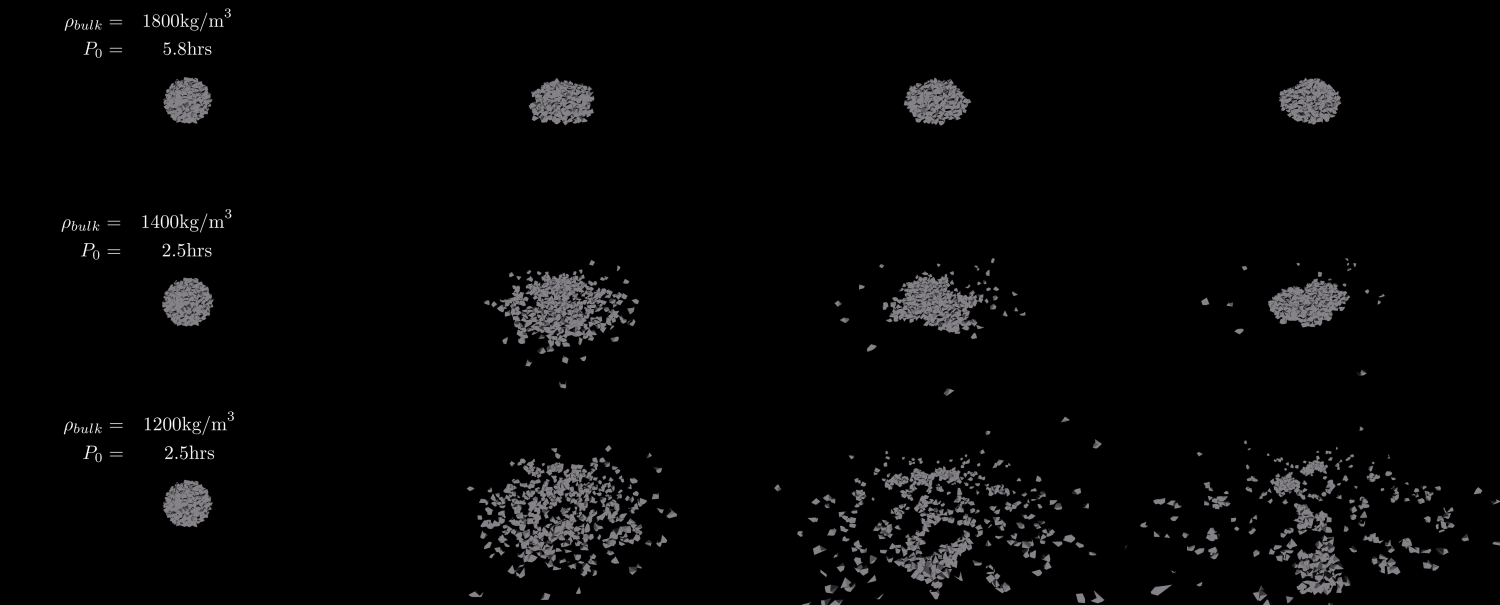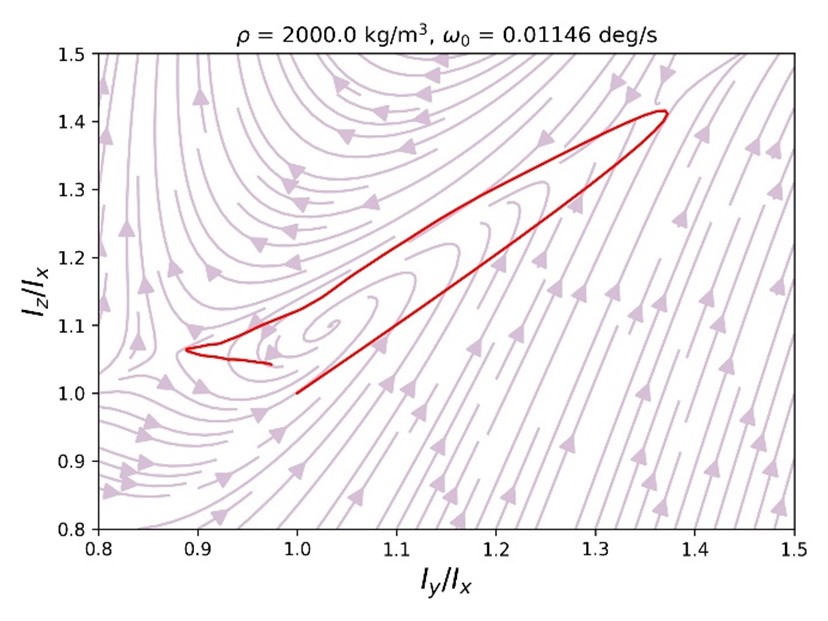Data-driven Estimation of Rubble-pile Asteroid Granular Dynamics
- Politecnico di Milano, DART lab, Department of Aerospace Science and Technology at the Politecnico di Milano, Italy (iosto.fodde@polimi.it)
Introduction
Rubble-pile asteroids, which are defined to be bodies consisting of loosely consolidated material that is mainly held together by gravity, are currently believed to be a significant part of the asteroid population. The origin and evolution of these types of bodies are governed by granular mechanics and are highly dependent on external excitations like meteoritic impacts, the YORP effect, and planetary encounters[1]. Universal modelling of granular systems is one of the major unsolved topics in physics, as these systems are chaotic, multi-scale, and highly dependent on the non-linear interactions between their constituent particles. Most analytical models are derived on the basis of continuity of the body and omit their complex granular nature [2]. These models can explain some observations, but are not capable of fully modelling their complex dynamics. On the other hand, numerical simulations implementing different contact models and particle properties have shown a great potential to predict the evolution of these systems. However, their long computation times and sensitivity to initial conditions make it harder to generalize their results. This work tries to bridge the gap between numerical and analytical modelling of rubble pile asteroids, by using the data produced by numerical simulations to derive a set of analytical equations of motion that can be generalized to systems outside the generated simulation dataset.
GRAINS
In this work the GRAINS N-body code is used [3] to obtain high-fidelity simulation data for the shape dynamics inference. GRAINS models both the gravitational attraction between different particles in the simulation, together with the interaction upon contact between two complex shaped particles. The inclusion of the shape of individual particles increases the fidelity of particle-particle interactions compared to the spherically shaped particles that are mostly used in other N-body simulation. The state of each particle is saved over time and converted to some macroscopic state variable. These state variables can be physical variables like energy, the moments of inertia, or some angular momentum components. Besides the state variables, other environment, i.e. static, variables like the spin-up rate and bulk density are considered as well. Then, multiple simulations can be run with different values for the environment variables to obtain a large dataset containing different dynamical regimes, see Figure 1.

Figure 1 Three different GRAINS simulations at different time snapshots.
Sparse Symbolic Regression
Symbolic regression techniques aim to identify functional relationships present in large datasets. Machine learning based methods like genetic programming or neural networks have been shown to work well in predicting complex non-linear dynamical systems from data. However, key properties of good analytical models, like interpretability and generalizability, are often neglected by these methods. For this reason, the sparse identification of non-linear dynamics (SINDy) method was developed in [4]. The SINDy method avoids this problem by applying a sequential thresholding least-squares algorithm to the problem to promote sparsity in the final equations of motion. This research takes the data produced by GRAINS and uses the SINDy method to identify the analytical governing dynamical equations. Allowing for more in-depth analysis of the data produced by these simulations.
Results
Some first results were produced by taking a set of 110 simulations from GRAINS with each simulation consisting of a different combination of initial spin rate, and bulk density. Each simulation consists of 800 particles and runs for 5 hours in simulation time. As is common for regression problems, to avoid overfitting only 80 percent of simulations were given to SINDy to generate a model, and the other 20 percent were used as a validation test set. A relatively simple SINDy model was created using a 3rd degree monomial function library, tuning the thresholding value to obtain a satisfactory result. A comparison between the time evolution of the rubble pile’s moment of inertia ratio for one of the validation simulations and the produced SINDy model is given in Figure 2. The arrows represent the dynamics of the system, and the solid line is the result from GRAINS. Qualitatively, the simulation follows the arrows from the analytical model, which shows a spiralling structure towards an equilibrium point. Other coherent structures can be observed as well, which separate the flow into different regions

Figure 2 The flow field of the SINDy model (light color) compared to a GRAINS simulation.
Conclusion
The high reconstruction accuracy and the potential information that can be inferred from these models presented here show the promise of the SINDy method for modelling the granular mechanics of rubble-pile asteroid. These simulations only considered single initial shapes for each density and rotational rate setup, thus increasing the amount of data can improve the reliability of the analytical model. Furthermore, other simulation setups with more particles, large inner cores, or other external excitations that mimic the actual evolution of a rubble-pile asteroid will be included as well.
Acknowledgements
Funded by the European Union (ERC, TRACES, 101077758). Views and opinions expressed are however those of the authors only and do not necessarily reflect those of the European Union or the European Research Council. Neither the European Union nor the granting authority can be held responsible for them.
References
[1] Hestroffer D, Sánchez P, Staron L, et al (2019) Small Solar System Bodies as granular media. The Astronomy and Astrophysics Review 2019 27:1 27:1–64. https://doi.org/10.1007/S00159-019-0117-5
[2] Holsapple KA, Michel P (2006) Tidal disruptions: A continuum theory for solid bodies. Icarus 183:331–348. https://doi.org/10.1016/J.ICARUS.2006.03.013
[3] Ferrari F, Tanga P (2020) The role of fragment shapes in the simulations of asteroids as gravitational aggregates. Icarus 350:113871. https://doi.org/10.1016/J.ICARUS.2020.113871
[4] Brunton SL, Proctor JL, Kutz JN (2016) Discovering governing equations from data by sparse identification of nonlinear dynamical systems. Proc Natl Acad Sci U S A 113:3932–3937. https://doi.org/10.1073/PNAS.1517384113/SUPPL_FILE/PNAS.1517384113.SAPP.PDF
How to cite: Fodde, I. and Ferrari, F.: Data-driven Estimation of Rubble-pile Asteroid Granular Dynamics, Europlanet Science Congress 2024, Berlin, Germany, 8–13 Sep 2024, EPSC2024-1036, https://doi.org/10.5194/epsc2024-1036, 2024.